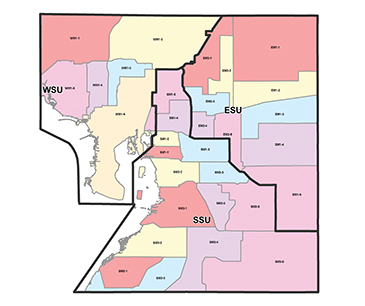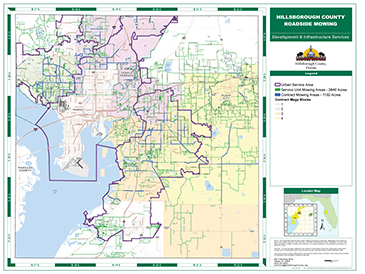



Feature Story
More feature stories by year:
2024
2023
2022
2021
2020
2019
2018
2017
2016
2015
2014
2013
2012
2011
2010
2009
2008
2007
2006
2005
2004
2003
2002
2001
2000
1999
1998
Return to: 2015 Feature Stories
CLIENT: LA CONSULTING
June 2015: Civil + Structural Engineer
Hillsborough County's two-phase process cuts costs, improves operations, and increases service.
W. Roger Cox, P.E., Jeff Thurman, C.P.M.

In late 2010 and continuing into 2014, Hillsborough County, Fla., embarked on a two-phase process of cultural change and process improvement. The goals were to establish a baseline of current operations, develop and identify opportunities that would improve operations, and formulate recommendations that would lead to improvements and implementation strategies to ultimately enhance work methods and management efforts. The review was not an audit but an internal effort to improve, consistent with their mission statement and guiding principles. The initial phase was a top-to-bottom review to determine the most effective and efficient way to deliver high-quality responsive service. While the review revealed that the county was performing at a high level in many areas, several opportunities were identified for improvement.
Hillsborough County is located on the west coast of Florida, southwest of Orlando. The county has 1,051 square miles of land and an additional 215 square miles of water. With approximately 158 miles of shoreline on Tampa Bay, the county's coast makes it the largest bay in Florida, which also opens to the Gulf of Mexico. The population has grown consistently and is expected to grow by 1.58 million by 2030. The county draws more than 15 million tourists annually, increasing the county's traffic and infrastructure use and placing an extra emphasis on repair and maintenance.
The Transportation Maintenance Division (TMD) maintains more than 3,300 centerline miles of roadway. The road miles are the state's third largest, and Hillsborough has more road miles than Hawaii, Road Island, New Jersey, Vermont, and Massachusetts DOTs combined.
In addition to the pavement features, the TMD is responsible for maintaining approximately 2,500 miles of sidewalks, 119,000 sidewalk ramps, 3,000 miles of curb, 3,500 miles of shoulder, 1,200 miles of culverts, 1,200 miles of ditches, 7,000 stormwater manholes and junction boxes, 2,400 control structures, 72,000 end treatments, 14,000 headwalls, and 2,200 detention/retention ponds. It also has responsibility for maintenance of 251 bridges. The county has a total asset value of more than $10 billion.
The path of evaluation was to follow the four phases of ideal maintenance management, including planning, organizing, scheduling, and controlling. The result of the evaluations was a complete outline of the current state (baseline), identification of 86 opportunities for improvement, and 68 key recommendations that comprised all four phases of the ideal maintenance management agency. The review's final report served as a game plan to achieve the goals of an efficient and effective organization. After evaluation and development of the game plan, it was time to implement its recommendations, charting a path to improvement.
Initially, Hillsborough County had to re-establish and define the maintenance and repair activities they perform and determine which assets they were responsible for. This first step used a combination of the institutional knowledge of employees, GIS technology, and other manual and automated databases. They utilized ESRI ArcGIS to create maps of assets, boundaries, and other features. Managers, supervisors, and field staff reviewed the maps for accuracy and completeness, using technology as a tool to assist in this process but using staff knowledge to assist (not direct) the effort.
The final report of the review process also included, as a recommendation, creation of an overall planning section designated to work with all of the field units and acquisition of a new computerized maintenance management system (CMMS) to replace the existing system. The purpose of the planning section was to provide guidance, oversight, and accountability for the work performed by the county's field units. This ensured that the work outlined as part of the department's annual plan was fully transparent to the crews and management at the field units, as well as providing user support and data integrity and process checks. The county selected MaintStar version 12.0.104 CMMS, as outlined in the review process, to be able to integrate with the GIS, allowing for spatial data and relationships to be fully understood and used to create viable maintenance plans.
Further, using technology as a tool for improving the planning, organizing, and scheduling of work, the TMD utilized a combination of technology and manual processes to develop maintenance routines to address the goal of planning at least 80 percent of its work and concentrating on the "significant few" that have the largest impact on the organization. From its initial effort of defining activities with resource needs, levels of effort, and knowing its responsibilities, the TMD was able to develop routines for most of its work activities. They now know the what, how, where, and when of their maintenance work.
For example, with the activities of right-of-way mowing, tree trimming, sidewalk repair, and ditch cleaning, TMD utilized GIS to establish routines and create operational blocks for efficient execution by maintenance resources. The top activities were mapped and scoped to quantify their efforts. Most operational blocks were based on the amount of work that can be produced in a two-week time period, which correlates to the time period established for the short-term scheduling process that has been established. With known quantities and established average daily productions, they are able to calculate productions and levels of service for each activity. Through this, the TMD is able to measure the effectiveness of field crews and create accountability.
For mowing, operational blocks were established that have the acreage to be mowed in a specific time period. For tree trimming, they have operational blocks with specific linear feet of trees to be trimmed. Figure 1 illustrates the developed operational blocks for right-of-way mowing. For canals they measure the linear feet of canals to be cleaned. The division has also developed operational blocks for hand, slope, and canal mowing.
As a result of establishing operational blocks and routines for several of maintenance activities, levels of service have increased by doing more work with the same or less resources. For example, right-of-way mowing cycles have increased more than 48 percent, with some units doubling their turns as compared with before implementation of operational blocks. They also developed a routine for canal cleaning that will allow the canal system to be maintained on fiveyear cycles; previously, portions of the system had no maintenance recorded since maintenance records have been kept.
Other technologies were also established and are currently being utilized to accomplish recommendations from the game plan and achieve their goals. For example, as the result of the Service Unit's maintenance yards being geographically too far apart to meet bi-weekly, remote Web-based meeting technology such as GoToMeeting is now being used to review previous bi-weekly schedules, complete audit work, establish work schedules, and increase communication and cooperation between groups. As a result, the Service Units can present schedules, check with field operations for final adjustments to schedules and work, as well as monitor overall progress. Units can coordinate equipment needs and potentially insert work into the schedule. Long-term projects can also be discussed, which has led to transparency and has given all employees a feeling of ownership and involvement in the operations. Meetings can be recorded for playback by absent staff members or can be used for accountability.

The division identified, and now focuses on, its primary activities by using the Pareto's Law concept, where 20 percent of its activities accounted for 80 percent of the budget. This resulted in vegetative control activities — tree trimming, roadside mowing (Figure 2), and ditch cleaning — being the largest work effort. The emphasis is to work on the activities that make the most impact and resist working on activities that add little value. As an example, Hillsborough County developed and implemented several tasks into routine maintenance cycles, each based on several factors, including assets that they are responsible for, available resources, and the levels of service determined for each activity.
While applying this methodology to one of the highest requested activities, they developed and implemented mowing blocks. As a result, mowing cycles have increased overall by 25 percent system wide, with some units doubling mowing frequencies. Tree trimming and removals are another area of considerable success. After identifying 100 percent of the needs, routines were developed and resources were deployed. TMD is projected to complete a tree trimming cycle every three years, thus increasing safety for the community and reducing the need for customers to call for requested service.
With development and execution of further routines in other activities, it is projected that TMD will realize similar efficiencies in service delivery to the customers of Hillsborough County. Through better planning, organizing, scheduling, and controlling processes and methods, they reduced backlog work orders by 57 percent and projected to reduce them by an additional 30 percent in the near future, reducing customer requests significantly. This includes eliminating all tree trimming requests in the county.
For this type of review to be successful, elements of success are required. Buy-in to the process must occur on all levels prior to commencement. Senior management has to be committed to the entire process and must see it through every step. The right person must be chosen to lead the implementation of recommendations, ideally an employee who is and can be committed to the entire process from start to finish. Besides senior management's commitment, communication must occur at all levels and phases to obtain optimal results. Real data must be used and confirmed so that outcomes are accurate and quantifiable.
Anticipated results include that feedback to all levels of the organization will be provided and evaluated. Future developed processes and implementation of new technologies must match the organization's identified needs, further contributing to the goal of continuous improvement. All work will be systemized so that there will be increased quantifiable efficiency. Lastly, employees will feel involved and empowered, resulting in a feeling of transparency, ownership, pride, and job satisfaction.
The game plan was about establishing business processes for overall improvement. Hillsborough County reduced its budget, increased service, and lowered backlog by developing a plan. Second to developing a plan is the critical element of employee participation, ownership, and support for making improvements to the system. The success of this review has been documented in the observations of others in a performance audit that was conducted in December 2012 by an outside, independent auditing firm.
And according to an October 2010 report, "the department is transforming field operations in a positive way, and plans exist to expand this success… By extrapolating the recommendations to all functional areas, the department will be able to considerably improve the way business is conducted."
Hillsborough County's Public Works and TMD established and implemented a clear vision that focused on effectiveness and efficiency. As a result of the desire to continually improve operations, increase service, and reduce costs, Hillsborough County is becoming a national leader in public works efficiency, cost effectiveness, and customer service.
W. Roger Cox, P.E., is manager, Hillsborough County, Fla.
Jeff Thurman, C.P.M., is a consultant with LA Consulting Inc.
Return to: 2015 Feature Stories